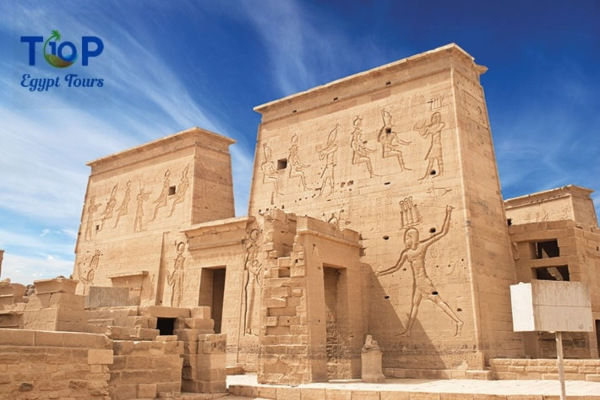Philae Temple Complex: A Jewel of Ancient Egyptian Architecture Philae Temple, famously known as the Temple of Isis, stands as a magnificent island sanctuary nestled on Agilkia Island within the Aswan reservoir, downstream of the Aswan Dam and Lake Nasser in Egypt. Devoted to the revered goddess Isis, this temple complex is celebrated as one of ancient Egypt’s most stunning and well-maintained sanctuaries.
In this article, we will uncover for you the Temple of Isis with Top Ten Egypt
Architectural Marvel Of Philae Temple Complex:
Behold the Splendor of Philae Temple Complex, a testament to Ancient Egyptian Ingenuity. The grandeur of this temple abounds with towering sandstone pylons, imposing columns, and intricately carved reliefs. Embark on a majestic journey through the temple’s adorned entrance, marked by colossal statues and embellished pylons, and step into the enchanting world of ancient Egypt.
Within the temple complex, visitors are greeted with a grand courtyard, a mesmerizing hypostyle hall, and a sacred sanctuary. The courtyard, surrounded by colonnades, showcases walls adorned with reliefs depicting captivating scenes from the mythos of Isis. The vast hypostyle hall, supported by massive columns, and the sanctuary, housing the statue of Isis in ancient times, unveil the temple’s profound architectural and spiritual significance.
Historical Import:
Spanning centuries from the Ptolemaic period (305-30 BC) to the Roman era (30 BC-476 AD), the Philae Temple Complex pays homage to the revered goddess Isis, symbolizing love, fertility, magic, and healing in ancient Egyptian beliefs. A renowned religious hub, the temple attracted pilgrims worldwide seeking blessings from Isis. It also served as a hub for knowledge in astronomy, mathematics, and medicine, showcased by its learned priests.
Preservation of Cultural Heritage:
Philae Temple Complex stood as one of the last active ancient Egyptian temples, witnessing worship until the 6th century AD before transitioning to a Byzantine church under Emperor Justinian I. In the 19th century, it emerged as a cherished tourist destination. Threatened by the Aswan High Dam’s construction in the 1960s, an international endeavor salvaged the temple, relocating it to Agilkia Island in 1979.
Artistic Masterpieces:
Philae Temple’s walls resonate with exquisite reliefs and hieroglyphics, portraying the Isis myth, religious rituals, and historical chronicles. Notable treasures include the depiction of Ptolemy II Philadelphus honoring Isis on the entrance pylon, the portrayal of Horus’s birth on the north courtyard wall, and the mesmerizing inscriptions within the sanctuary.
Cultural Immersion:
A journey to the Philae Temple Complex offers a profound immersion into ancient Egyptian culture and history. The temple’s architectural opulence, intricate reliefs, and hieroglyphics provide a gateway to the rich tapestry of the Ptolemaic and Roman periods. Visitors delve into the religious practices and artistic achievements of ancient Egypt, fostering a deeper connection to the country’s cultural legacy.
Set an unforgettable Aswan Day Tour to witness the awe-inspiring Philae Temple Complex. This iconic sanctuary, dedicated to the goddess Isis, is a must-visit for history enthusiasts and culture seekers alike. Immerse yourself in the grandeur of ancient Egyptian architecture, explore the intricate reliefs, and uncover the mysteries of this sacred site. With its stunning location on Agilkia Island, the Philae Temple Complex offers a truly magical experience.
Browse our complete list of Egypt tours and join our 2 days Aswan and Abu Simbel trip from Cairo.



Comment (0)